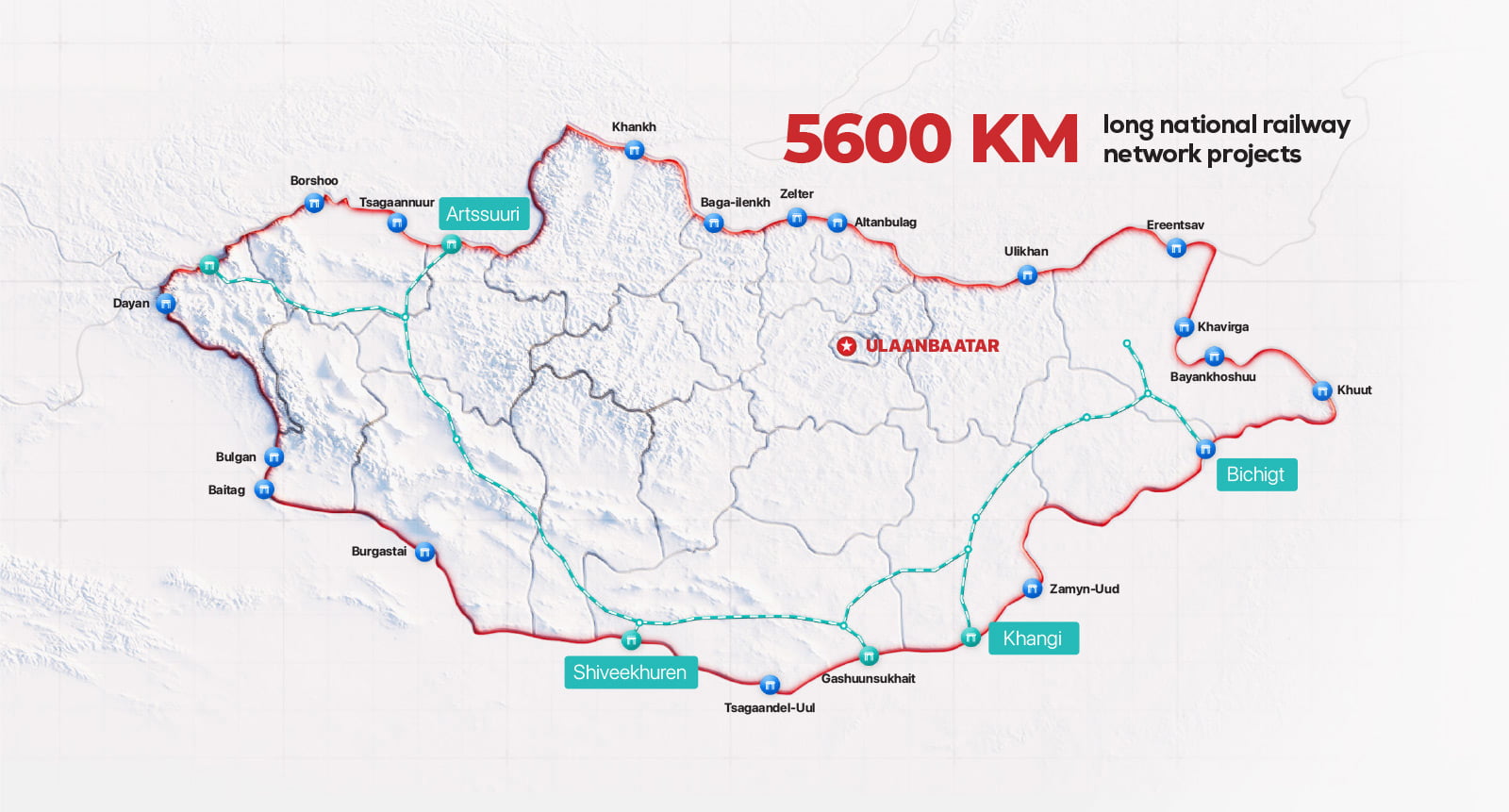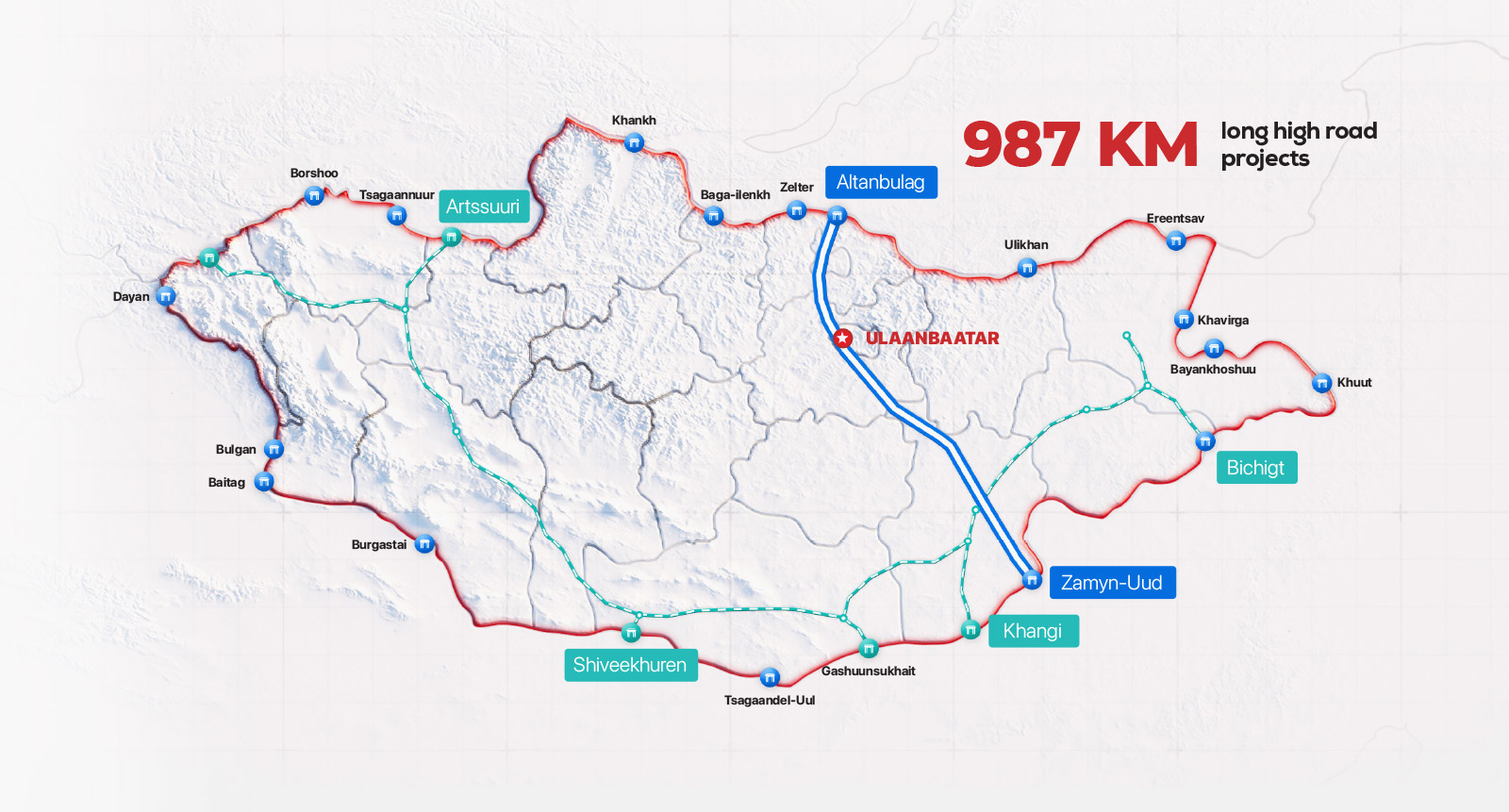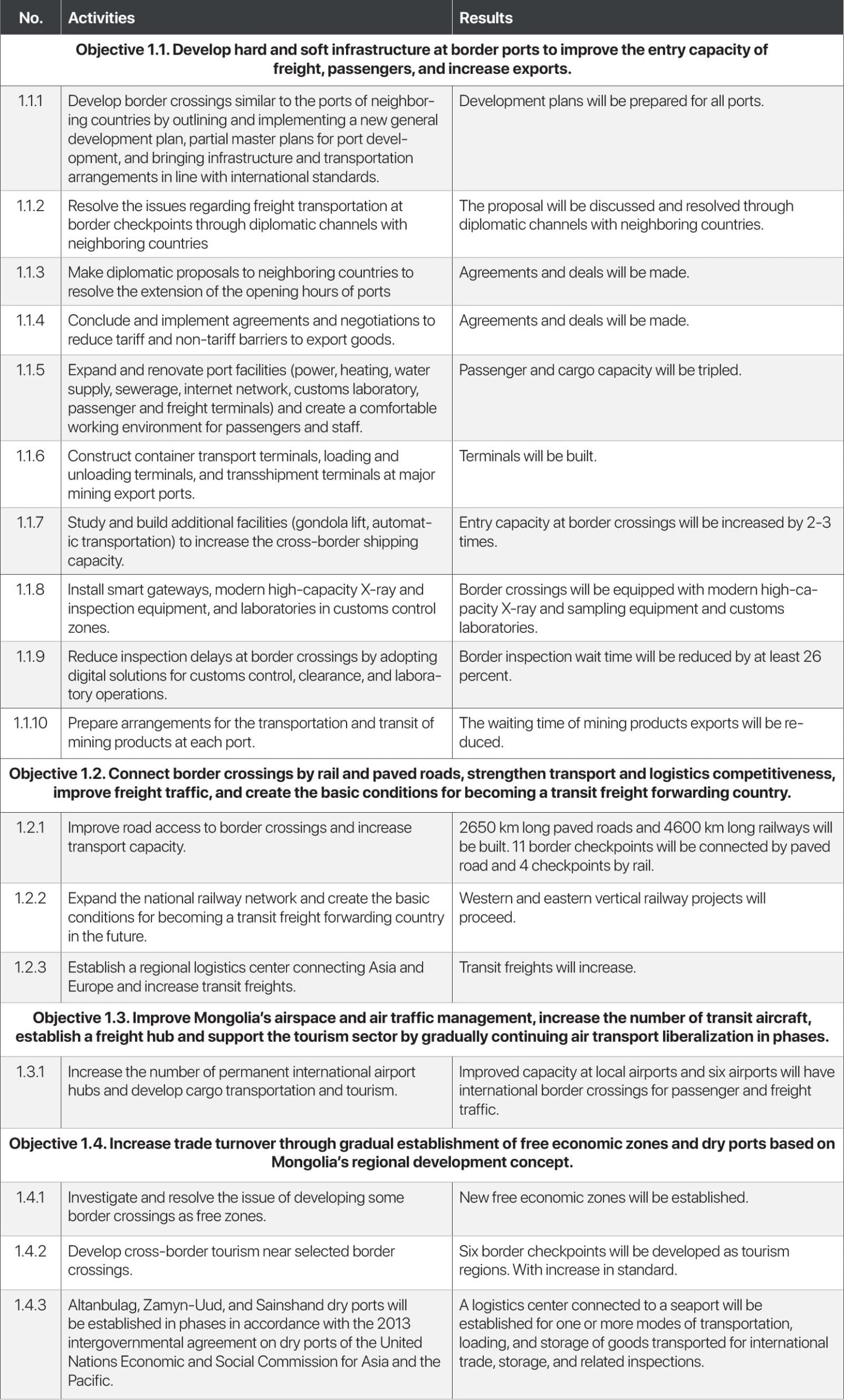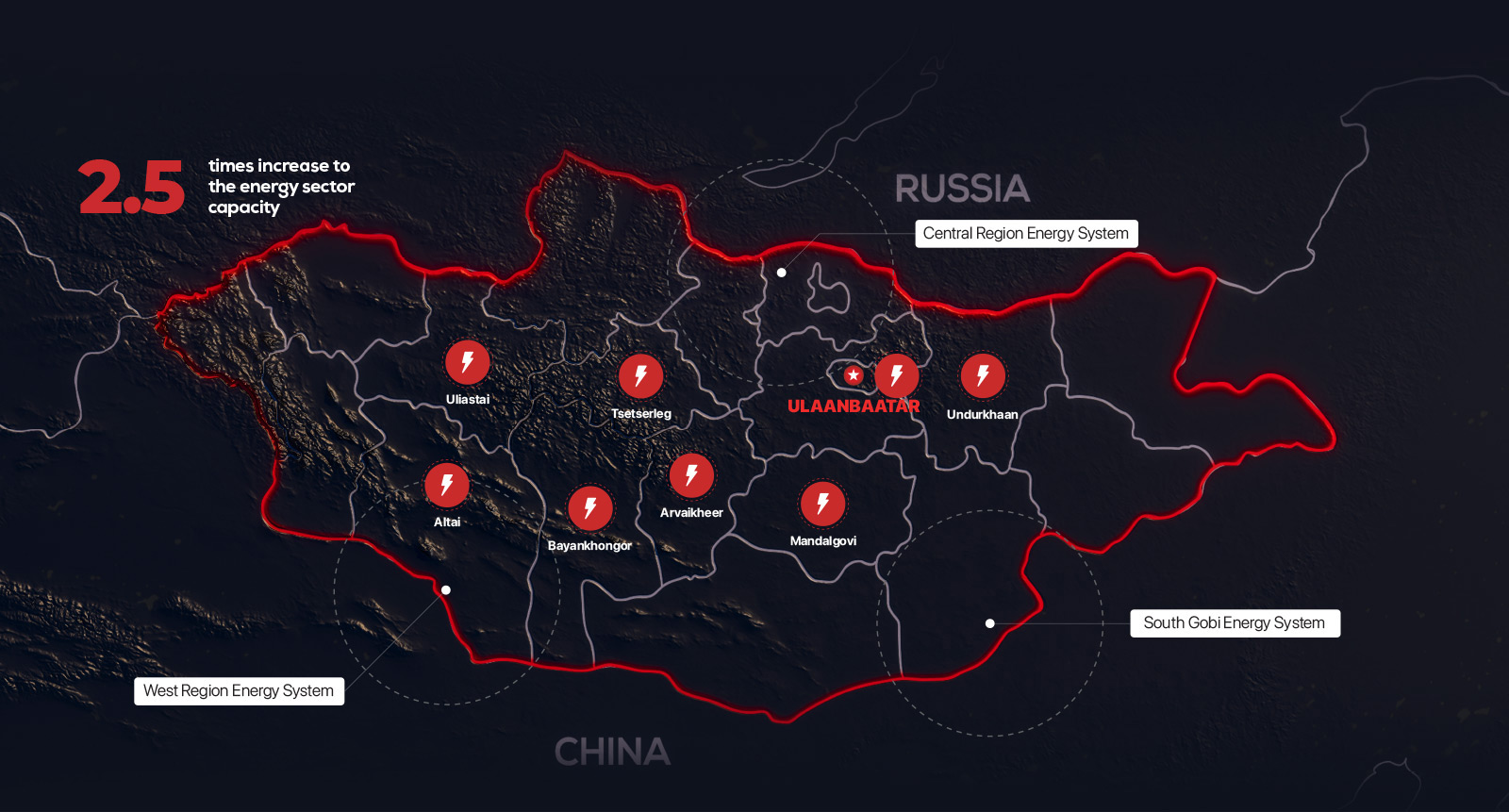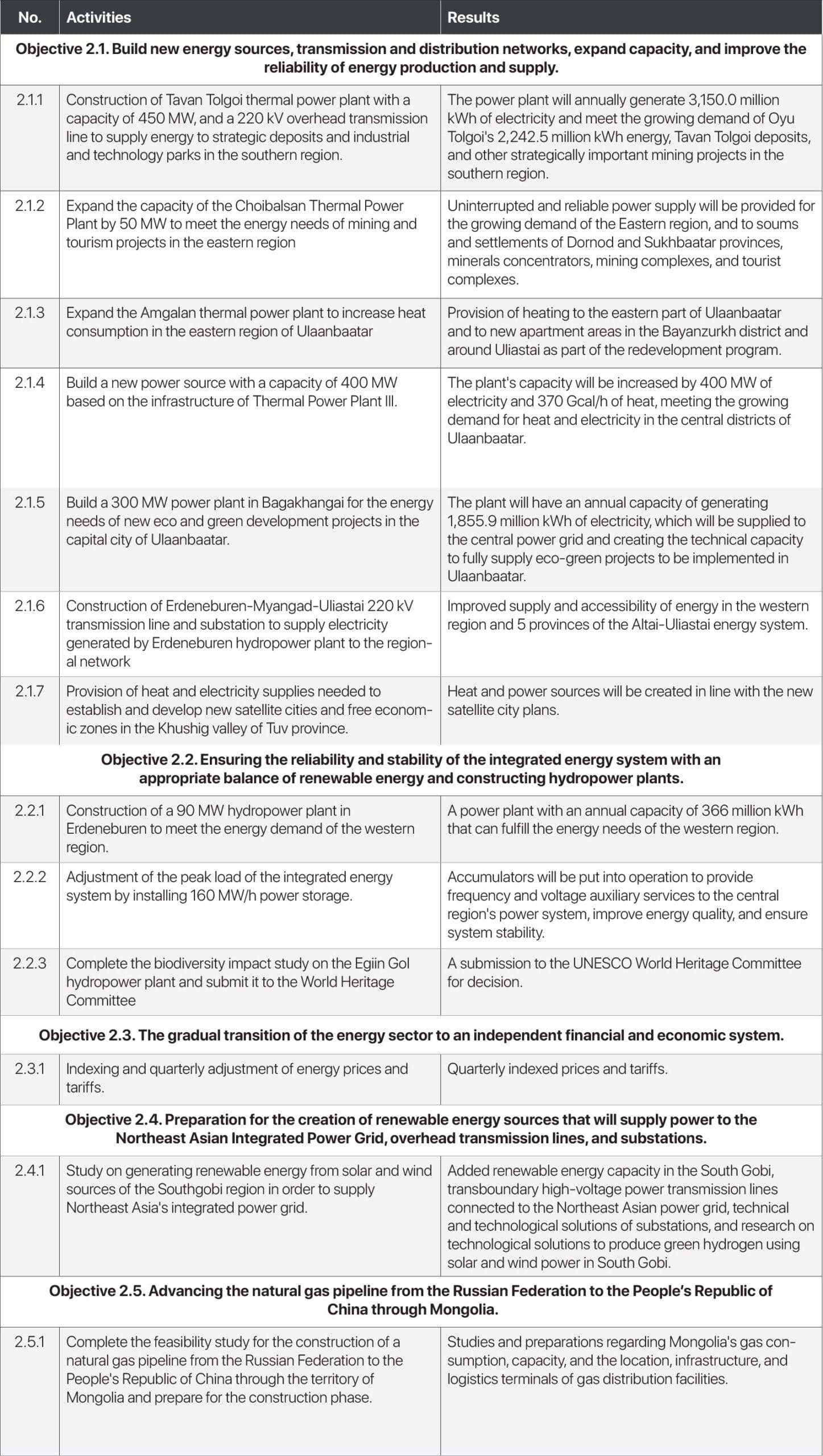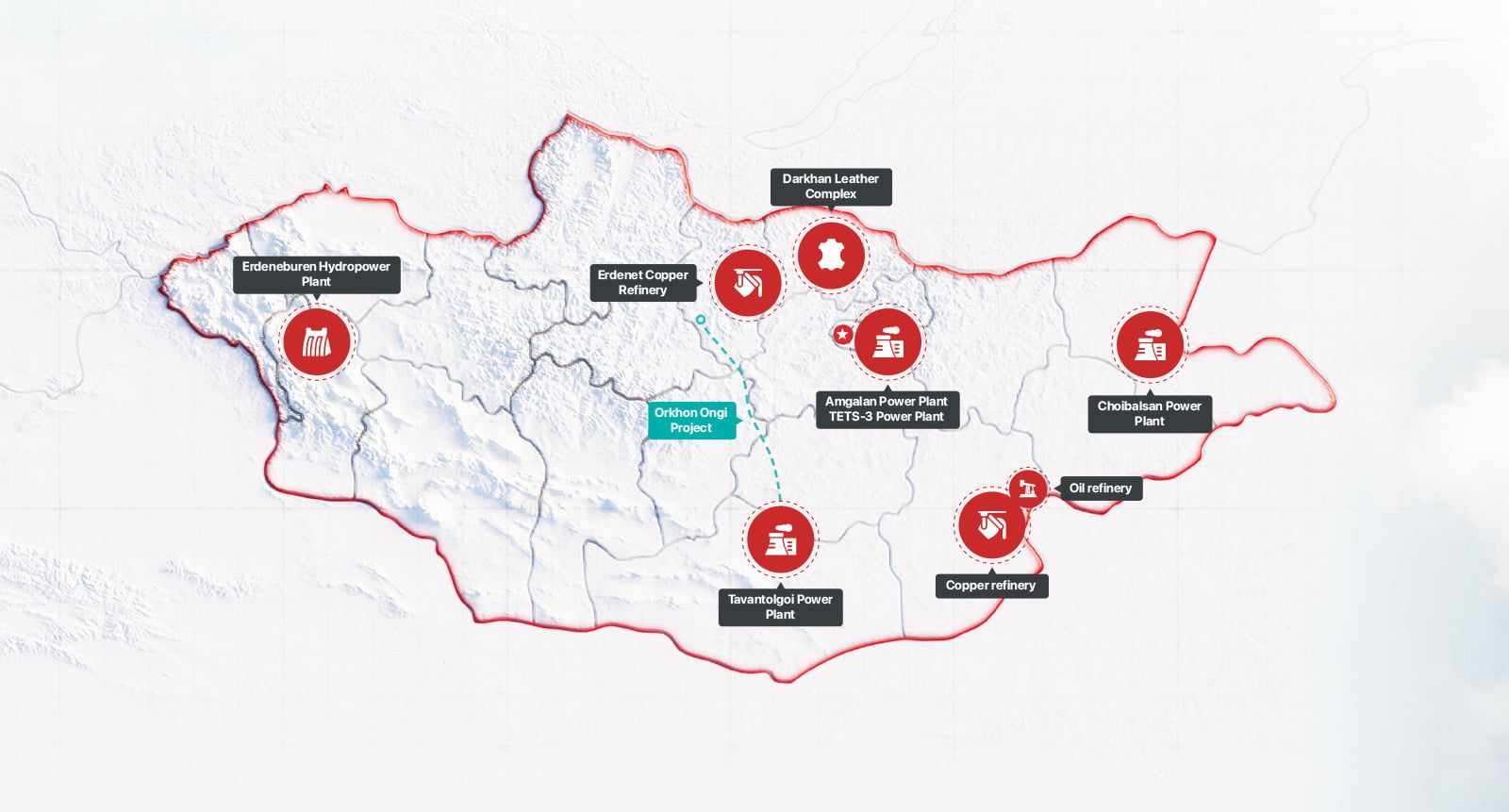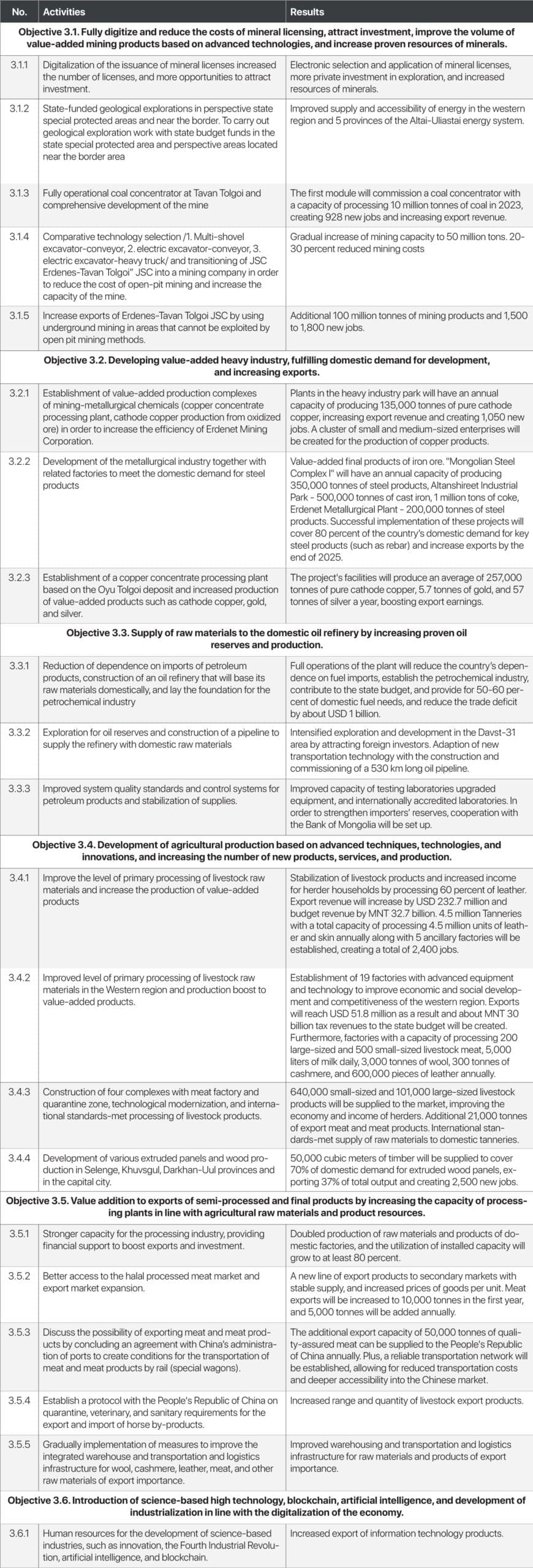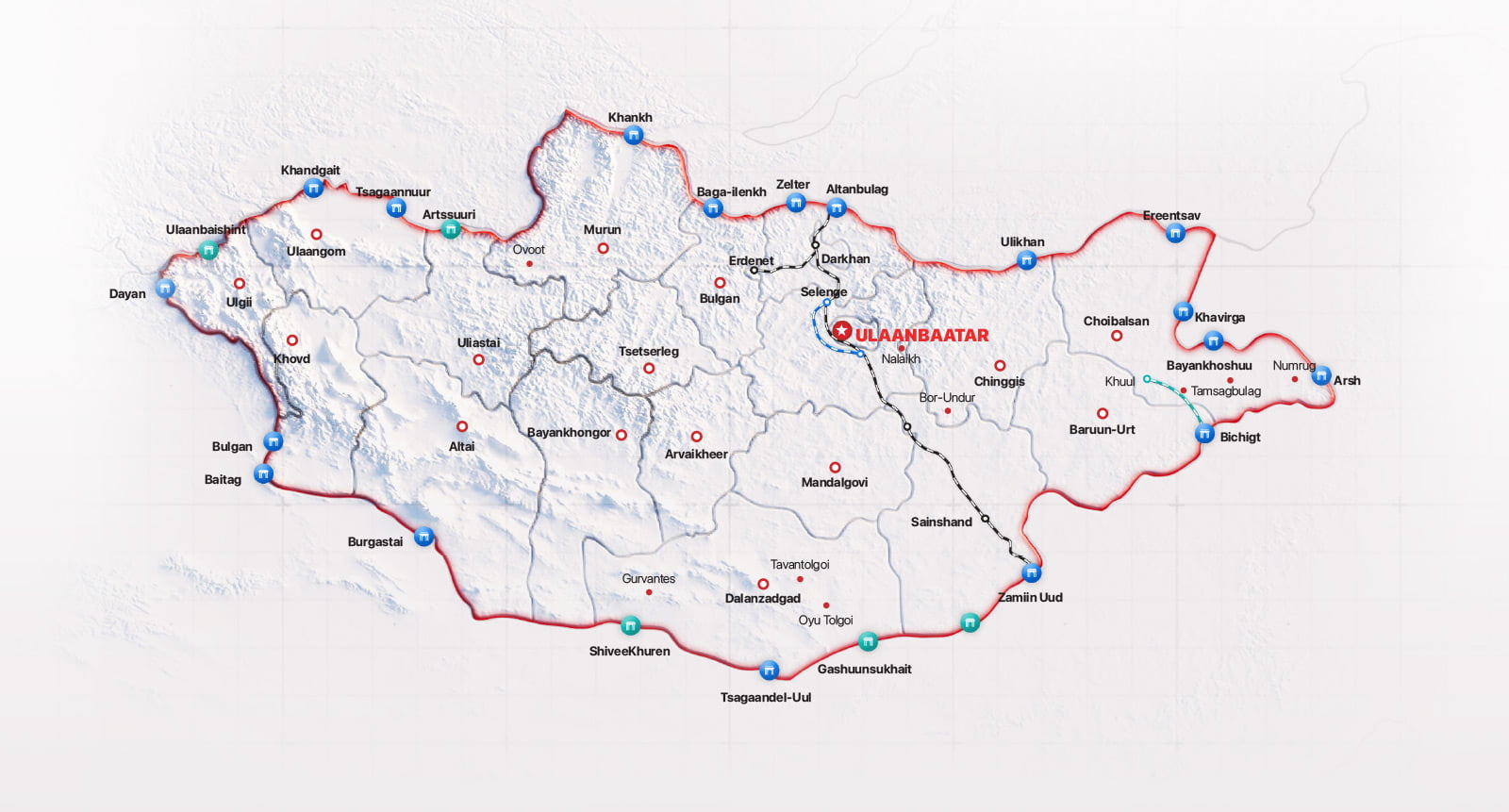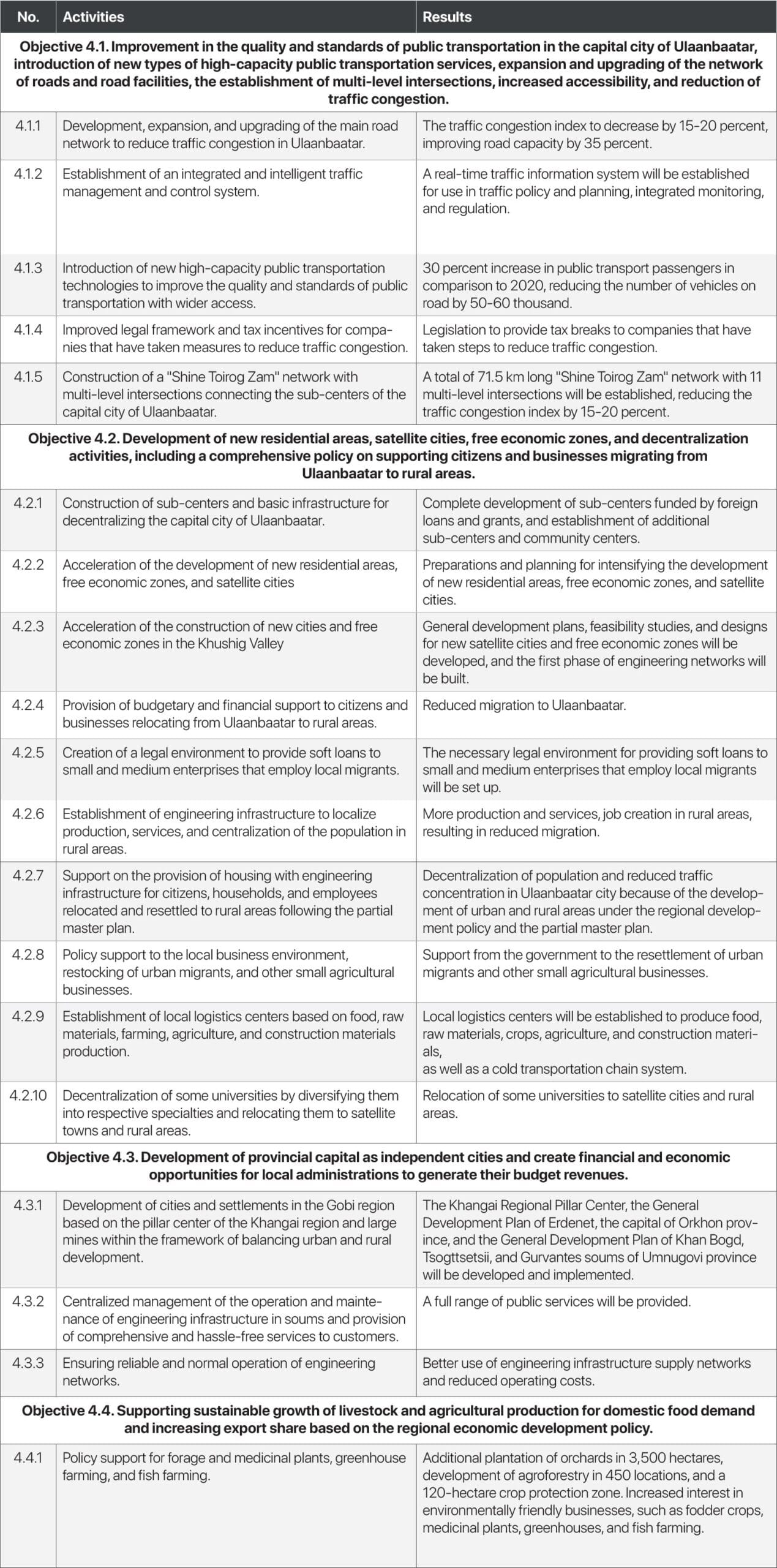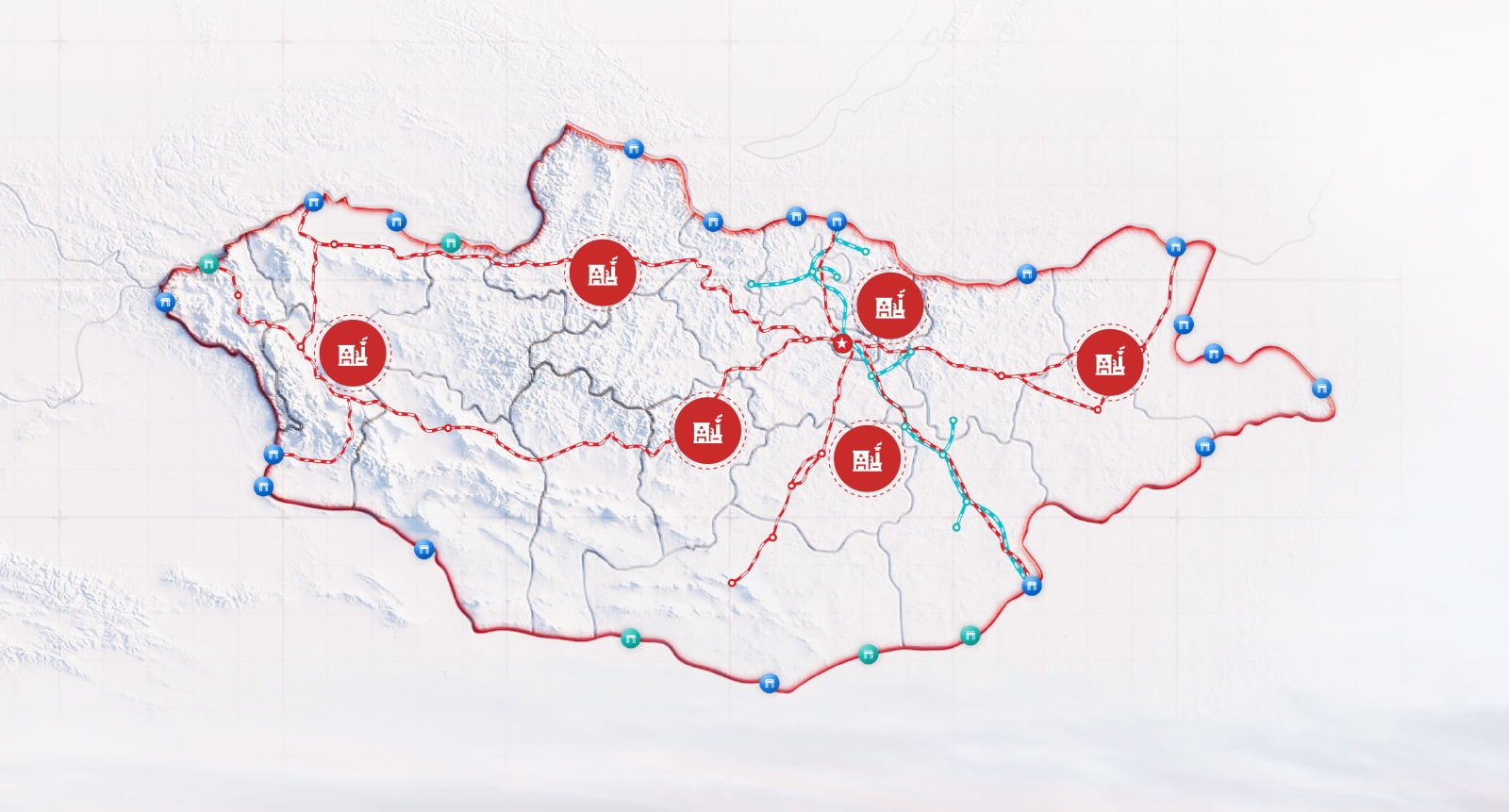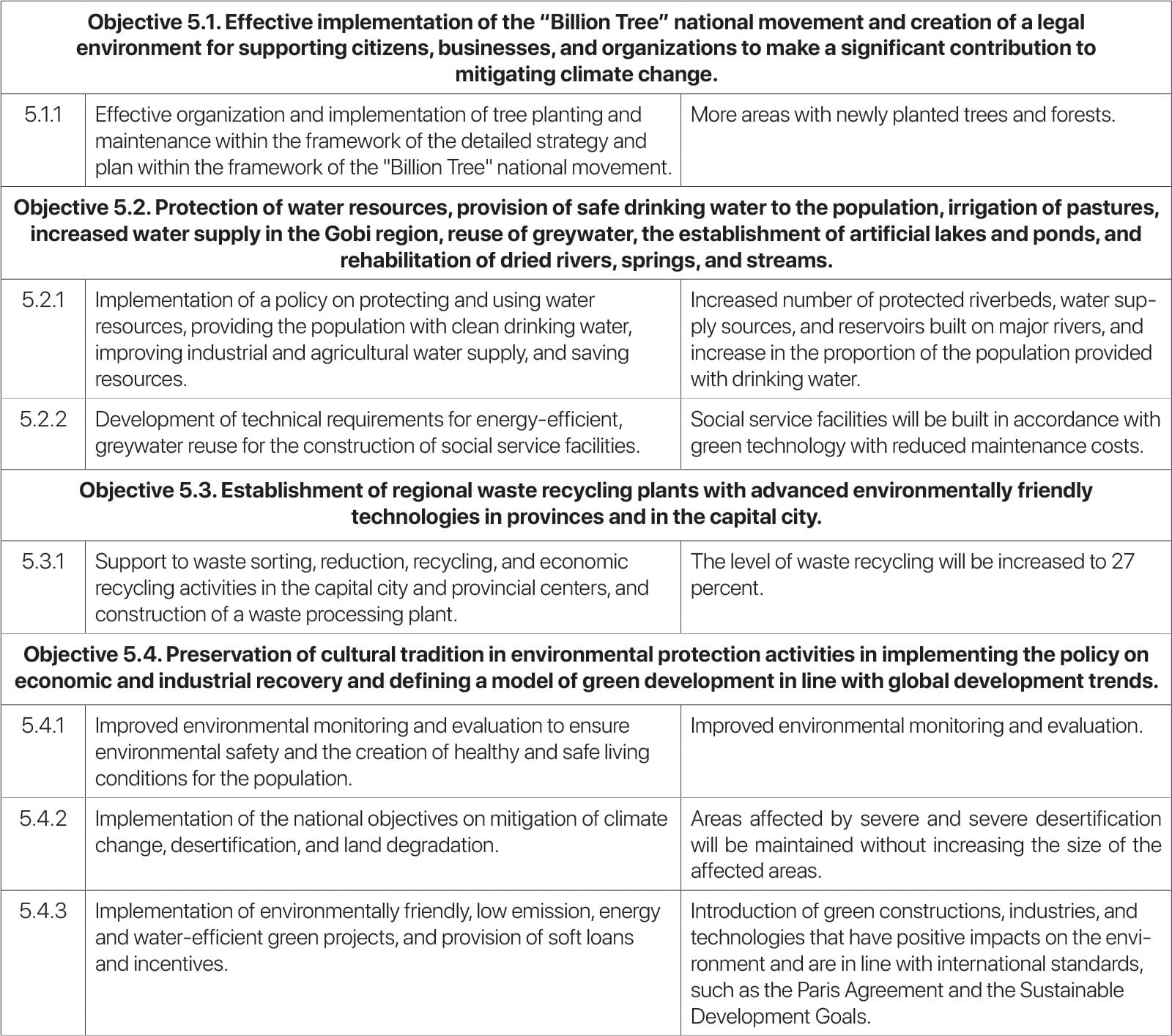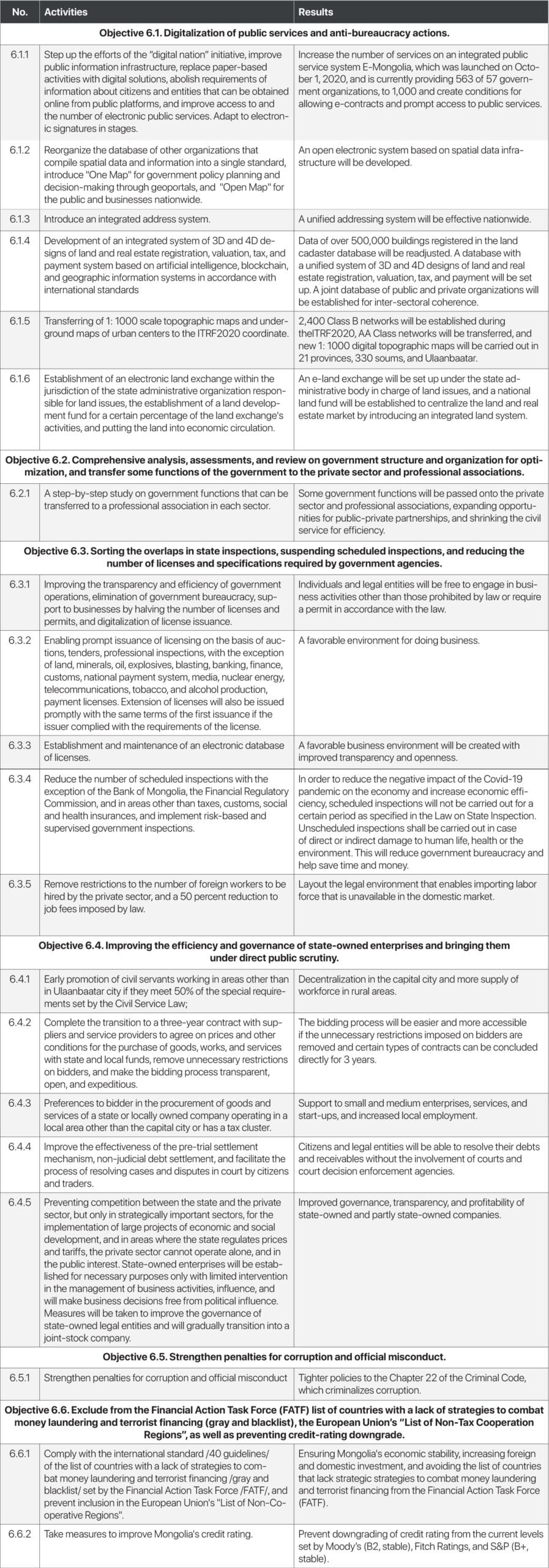The Government introduced the “New Recovery Policy” in 2021 and got it approved by the Parliament.
The policy is aimed at strengthening the economic independence of Mongolia, reducing the economic impact of the coronavirus pandemic, and resolving the factors obstructing the development of the country.
New Recovery Policy is a mid-term development program that will be effective for up to 10 years, complementing the effective implementation of Mongolia’s long-term development policy “Vision 2050”, improving the economic situation, infrastructure, and productivity of the state.
MNT 100-120 trillion will be required for implementing the New Recovery Policy for its duration of 10 years. The government announced that they will not finance this from the state budget, but instead, will tap into foreign and domestic markets, as well as public and private partnerships to raise investment by creating a favorable environment through legal reform.
RESULTS OF THE “New Recovery Policy”:
- The economic growth will be kept at around 6 percent in the long-term, and the per capita income will double, and labor force participation will increase to 65 percent.
- Tripled capacity at border crossings, doubled exports, and 2.5 times growth of energy capacity. (Estimated to triple capacity at border crossings, double exports, and 2.5 times growth of energy capacity.)
- The government views that the first phase of activities forwarded on the “Vision-2050” development policy will be enabled with the recovery policy.
Within the frames of the “New Recovery Policy”, the following six complex problems limiting the development of Mongolia will be addressed on the back of active public-private sector partnerships and investors.
ONE. Recovery of Border Crossings
The Government perceives that Mongolia, as a landlocked country, must promptly connect border crossings by road, rail, and highway infrastructure, and step up the development of the aviation industry. Within this frame, the issues regarding border crossings have been prioritized on the New Recovery Policy.
The government completed construction of the railway along the Tavantolgoi-Gashuunsukhait route in 2022 and is planning further railway projects connecting the Khangi, Bichigt, Shiveekhuren, and Artssuuri border crossings. This will create a 5,600 km long national railway network and lay the foundation for the “Transit Mongolia” initiative promoted by the president.
Furthermore, it includes objectives of road connectivity to some border crossings, including Khangi, Tsagaandel, Burgastai, Tsagaannuur, Tes, Artssuuri, Khankh, Baga Ilenkh, Zelter, Ulikhan, Khavirga, Sumber, Bayankhoshuu, and Bichigt, and strengthening of regional economic competitiveness in phases. The initiative on connecting border crossings with a highway will begin with a 987 km long highway in the Altanbulag-Zamyn-Uud route.
New Recovery Policy on railway network
New Recovery Policy on high road projects
LIST OF PROJECTS TO BE IMPLEMENTED:
-
Railway connectivity projects
/Gashuunsukhait-Gantsmod, Tavantolgoi-Tsogttsetsii/ -
Projects on upgrade and improvement of railroad network
/Projects on Ereentsav-Bayantumen route railroad and the upgrading of Sukhbaatar-Zamyn-Uud route main railroad corridor into a double-track railway/ -
Projects on constructing new railroad routes
/Choibalsan-Khuut-Bichigt, Sainshand-Baruun-Urt-Khuut, Artssuuri-Nariinsukhait-Shiveekhuren/ -
Construction of an international transit highway in the Zamyn-Uud-Altanbulag route, and connectivity of border crossings with paved roads.
/Khangi, Tsagaandel Uul, Burgastai, Tsagaannuur, Tes, Artssuuri, Khankh, Baga Ilenkh, Zelter, Ulikhan, Khavirga, Sumber, Bayankhoshuu, and Bichigt/ - Projects on expanding the “Chinggis Khaan” international airport into an international transit freight center, and increasing the capacity of airports in rural areas.
-
Projects on increasing the entry capacity of border checkpoints, and establishing cargo terminals.
/Gashuunsukhait, Shiveekhuren, Bichigt, Khangi, Ereentsav, Artssuuri, Altanbulag, and Zamyn-Uud/
Mongolia’s border status: The country has 42 inland ports, and 4 air borders. The country borders with Russia via 29 crossings, and with China via 13 crossings. As of today, 7 border checkpoints are connected by road, 3 by railway, and 1 by air. The country is ranked 130th with its port capacity out of 160 countries in the world.
EARLY-STAGE ACTION PROGRAM FOR THE IMPLEMENTATION OF “NEW RECOVERY POLICY”
ONE. RECOVERY OF BORDER PORTS
TWO. ENERGY RECOVERY
The energy sector is one of the biggest laggards to Mongolia’s development, according to the Government of Mongolia. Therefore, objectives in the “New Recovery Policy” are aimed at connecting to the Northeast Asian Super Grid and establishing a high-capacity overhead transmission line between Russia and China. Renewable energies, especially hydropower stations, will be given priority with plans to complete the Erdeneburen Hydropower Plant, and commence the development of Egiin Gol Hydropower Plant. The ongoing development projects, including the expansion of Thermal Power Plant III, construction of Tavantolgoi, Baganuur, and Choibalsan thermal power plants, and Amgalan Power Plant will be promptly completed.
New Recovery Policy on energy sector
LIST OF PROJECTS TO BE IMPLEMENTED:
-
Projects to expand the capacity of thermal power plants
Thermal Power Plant III, Thermal Power Plant II, Choibalsan Thermal Power Plant, Amgalan Thermal Power Plant, a distributed source of heat supply in Ulaanbaatar, and stoves and gas sources of Thermal Power Plant IV/ -
New energy projects
/Tavan Tolgoi Thermal Power Plant, Erdeneburen Hydropower Plant, Egiin Gol Hydropower Plant, 5th energy source of the Central Region, and Baganuur Thermal Power Plant. -
Power substation and overhead transmission line projects
/Erdeneburen-Myangad-Uliastai, Tavan Tolgoi thermal power plant-Oyu Tolgoi, Sainshand-Tsagaansuvarga, Baganuur-Undurkhaan, Baganuur-Choir, Mandalgobi-Arvaikheer, Baganuur-Nalaikh-Ulaanbaatar/ -
Environmentally friendly, science and advanced technology-based energy projects
/Nuclear, green-hydrogen, natural gas and renewable energy projects/
Current situation of Mongolia’s energy sector: The country couldn’t build any new source of energy since the establishment of Thermal Power Plant IV in 1986. However, the growing need for electricity is creating the necessity for thermal power plants. Mongolia annually spends over MNT 400 billion on energy imports.
Thermal power plants in Mongolia are 35-60 years old, while the transmission and distribution lines are 32-62 years old on average with over 40 percent being beyond the lifetime limits.
TWO. ENERGY recovery
THREE. INDUSTRIAL RECOVERY
The government is prioritizing the construction of processing plants for value-added products exports. Therefore, the government put forward objectives for copper concentrators, coal washing plants, gold and oil refineries, and domestic food plants to shy away from imported goods and create an industrialized economy.
As part of the New Recovery Policy, objectives on constructing value-added mining and agricultural processing plants in phases have been outlined. Within this framework, Erdenet copper concentrate processing plant, Tavan Tolgoi coal concentrator, and steel plants in the Darkhan-Selenge region will be built and put into operation. Also, a commitment on setting up a tannery in Darkhan and a sub-center for raw materials supply are in place.
NEW RECOVERY POLICY ON HEAVY INDUSTRY
LIST OF PROJECTS TO BE IMPLEMENTED:
-
Oil Refinery Projects
/Petroleum exploration, oil refinery, pipelines, and ancillary facilities projects/ -
Projects to develop Tavan Tolgoi and other coal deposits
/Projects on coal processing plant, water supply, adaptation of open-pit mining technology, and underground mining/ -
Projects on comprehensive use of Erdenet, Oyu Tolgoi, and other copper deposits, and increasing copper processing
/Projects on copper concentrate processing plant, cathode copper production from oxidized ore/ -
Projects to build industrial and technology parks
/Steel plant construction, mining-metallurgy-chemical production, industrial and technology park projects/ -
Projects to improve agriculture, farming and domestic food supply
/Darkhan tannery project, meat factory and technical renovation project for quarantine complex/
Current situation of Mongolia’s industrial sector: 90 percent of the country’s commodities are exported raw at low prices and 90 percent of domestic consumption is imported from abroad.
Although the country is an agricultural-based country with about 70 million livestock, statistics show that about 15 million units of hides are wasted due to the inability to process.
THREE. INDUSTRIAL recovery
FOUR. recovery IN CITIES AND COUNTRYSIDE
Due to the high level of urbanization in the capital city Ulaanbaatar, the population density currently exceeds capacity. As a result, the country’s economy has mostly concentrated in the capital, and the gap between the development of the capital city and the countryside is widening, causing a significant social problem. Thus, equal development of both the capital and rural areas has been included in the New Recovery Policy.
Within this frame, a detailed study on the construction of a new residential area equivalent to Ulaanbaatar based on the ancient capital city of Kharkhorum was launched in collaboration with international urban planning engineers, also kicking off development activities for establishing a free economic zone and a new city in the Khushig Valley.
Provincial capitals will also be developed into independent cities, opening up financial and economic opportunities for local governments to generate their own budget revenues, and increasing the authority and responsibility of local governments.
HIGH ROAD PROJECTS
As part of reducing traffic congestion, Ulaanbaatar’s public transportation system will undergo a complete renovation, and the construction of a 41-kilometer-long public transport with pier bridges in three directions will commence, with the first line planned to be completed by 2024.
The 136 km-long railroads surrounding the Bogd Khan Mountain that connects to the south of Ulaanbaatar will be reconstructed. By developing the Bogd Khan railroad, the railroad load inside Ulaanbaatar city is estimated to reduce by 50 percent. Construction of a 72-km long highway connecting the densely populated sub-centers of Ulaanbaatar is also included in the plan.
MAP OF BOGD KHAN RAILWAY PROJECT
LIST OF PROJECTS TO BE IMPLEMENTED:
-
Projects to reduce traffic congestion in Ulaanbaatar
/Projects on modernizing urban public transportation and introducing a new type of high-capacity public transportation service with a bridge structure, and building a “new ring road” in Ulaanbaatar./ -
Decentralization, new residential areas, urban infrastructure, and construction projects
/Projects on the establishing an economic zone in Khushig valley, Youth district, developing border crossings and settlements/
Current situation of Mongolia’s urban planning:
Mongolia ranks first in the world in terms of land area per capita. However, over 50 percent of its population lives in the capital, which makes up only 0.3 percent of the country’s territory. 90 percent of schools and universities, 86 percent of commerce and service, 81 percent of deposits, and 76 percent of registered private entities are centralized in the capital, which currently produces 65 percent of the country’s GDP.
Current situation of traffic congestion:
Ulaanbaatar residents spend an average of 2.4 hours a day and 35 days a year in traffic jams, resulting in lost opportunity costs of MNT 11.8 trillion over the last 10 years.
FOUR. recovery IN CITIES AND COUNTRYSIDE
FIVE. GREEN DEVELOPMENT RECOVERY
This objective includes measures to combat climate change. Within this frame, projects complementing the implementation of the Billion Tree movement initiated by the President of Mongolia by 2030 will be carried out.
The government has also promised to initiate a “Blue Horse” national program to irrigate pastures, supply water to the Gobi region, recycle gray water, create lakes and ponds, and rehabilitate dried rivers, springs, and streams.
New Recycling waste plant projects
LIST OF PROJECTS TO BE IMPLEMENTED:
-
Climate change mitigation projects based on advanced environmentally friendly technologies
/“Billion Tree” national movement, a project to build a centralized eco-facility for simple and hazardous waste/ -
Projects to accumulate water resources and increase access to water supply in the Gobi region
/‘Blue Horse” project/
Current situation of climate change in Mongolia: In Mongolia, the average annual temperature has risen 2.25°C for the last 80 years, which is twice the world average. It is estimated that 76.8 percent of the country’s territory is affected by desertification and land degradation, while 57 percent of all pastures are degraded.
FIVE. GREEN DEVELOPMENT recovery
SIX. GOVERNANCE RECOVERY
To improve governance, the government is taking wider measures for e-governance initiatives. The Government of Mongolia has set a goal to reduce the number of government licenses, signatures, and contracts issued to businesses by 50 percent in 2024, which will drastically reduce the human factor in civil services.
Mongolia is also actively working to reduce the bureaucracy of the civil service through digitizing them. E-Mongolia system, which was first introduced during the Covid-19 pandemic, brought online public services to Mongolians. As of 2024, more than 1200 public services of over 87 government agencies had been digitalized, and the system has over 1.7 million registered users. As a result of these efforts, Mongolia rose 28 places to reach 46th place in the United Nations E-Government Development Index (EGDI).
The policy also includes a step-by-step approach to improving the efficiency and governance of state-owned enterprises, which have been discussed for many years but have yet to materialize and to bring them under direct public scrutiny.
Mongolia scores low on the Corruption Perceptions Index, which the government perceives is substandard. The upcoming reform seeks to tighten penalties for corruption and official misconduct, monitor excess incomes of public officials, and align income tax returns with tax payments.
LIST OF PROJECTS TO BE IMPLEMENTED:
Projects to identify optimal government structures that are friendly to citizens, the private sector, and investors, and to digitize public services.
Current situation of corruption in Mongolia: In 2024, Mongolia scored 33/100 and ranked 114th out of 180 in Transparency International’s Corruption Perceptions Index.
